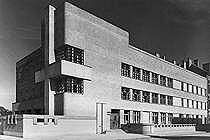
|
Way too modern Hans Steineder, architect (1904-1976) Location: Architekturzentrum Wien - Old hall Exhibition: 24 February 1999 - 05 April 1999 Press Preview: Tuesday, February 23, 1999, 11:00 a.m. Opening: Tuesday, February 23, 1999, 7:00 p.m. Open: Daily 10:00 a.m. - 7:00 p.m. TuesdayArchitecture: 01 - March 09, 1999, 7:00 p.m. 02 - March 16, 1999, 7:00 p.m. Tours: Saturday, February 27, 1999, 3:00 p.m. Saturday, March 13, 1999, 3:00 p.m. Saturday, March 27, 1999, 3:00 p.m. Catalog: The exhibition is accompanied by a catalog with an extensive list of Hans Steineder`s work (380.- ATS) Press / Information: Karin Wiederer T ++43 1 522 31 15 Ext. 23 F ++43 1 522 31 17 E-Mail: press@azw.at Way too modern Hans Steineder’s design for the Schulschwestern girls’ high school in Wels in the year 1927 was criticized as "too modern" by the client and initially rejected. Nonetheless, the Schulschwestern were pioneers in the architecture of Upper Austrian schools in the 30s. Steineder (1904-1976) was promoted and appointed house architect of the holy order after 1927, and five schools were erected in 1927, in Ried 1928-30, in Wels 1928-37, in Hallein 1929, and in Attnang Puchheim in 1934. He also participated in numerous housing projects and competitions. Behrens As a student of Behrens, Steineder has command of the grand architectonic gesture. He grasps form as an architectonic quality on an equal footing with constructive and functional needs and achieves both a symbolism and plasticity in his buildings comparable to a "Baroque variant of the de Stijl movement" (F. Achleitner). 1938 Steineder’s office is confiscated by the Nazis, he moves from Linz to Vienna. Post-war period Steineder reemerges in the spring of 1946 as an independent architect, participates in the competition for ideas for a new design of the Danube Canal, and actively takes part in the reconstruction of Vienna. Almost in parallel, he goes through a change of style, which is also manifested in a lecture Steineder holds at the architects conference in August 1947: pioneers of the modern movement, such as Behrens, Corbusier, Fuller, and Wright, are attacked for their utilitarian functionalism, construction and function as premises for the creation of architecture are condemned. In contrast to the materialistic-physical-universal world view, Steineder advocates the recovery of the lost metaphysical feeling and the revival of specific Austrian cultural values. Steineder’s stance is well reflected in his cityscape conservation work (Grinzing, Klosterneuburg, Melk, Kahlenbergdorf) or by the reconstruction of typical Austrian institutions such as the Heurige (Austrian wine tavern) and sites to commemorate musicians. This years main theme: (A)way with Modernism ? What is modern? At the moment, in these years, architects are very modern again. But what is modern? Steel, glass, transparency, puristic forms? Did not post-modernism discover modernism? Some 20 years ago, collective remembering and discovering was taking place. Wagner, Loos, Hoffmann, Frank, etc. "the Wiener Moderne", around the turn of the century, Jugendstil was a big seller. Art history and traders focused their research on the last turn of the century. And then ? The 20s, 30s, 40s, and 50s. Throughout all these decades, dramatic political changes, from the end of the 1st Republic, the Corporative State, the Nazi years, reconstruction. Fractures and continuities. The way with modernism or should it be better, considering all that happened, away with modernism? TuesdayArchitecture With four large retrospectives (Rudolf Schwarz, Hans Steineder, Erich Franz Leischner and Oswald Haerdtl) the Architekturzentrum Wien takes up and for the first time elaborates on the overlapping, continuities, and fractures within Austria’s history of architecture of the 20th century. The aim is to provide verbal opposition to the view focused on persons or on the "Forms of Architecture". The discourse centers on the correlation between the change in general political conditions, local power structures, and aesthetic orientation. The aim is to provide a retrospective reiteration before the turn of the millennium of the beginnings of architecture - for a better understanding of today. Sponsored by: Stadtplanung Wien, Wien Kultur, Kunst Bundeskanzleramt, Eternit, Schindler, Wiesner Hager, Zumtobel Staff |
 |
|
© Architekturzentrum Wien |
|
Current Preview Permanent Exhibition Way too modern Press Release Biography |
| © Architekturzentrum Wien 2024 |
||



